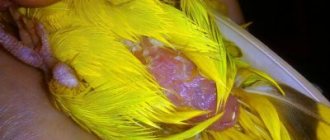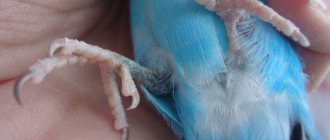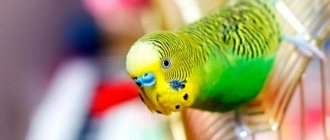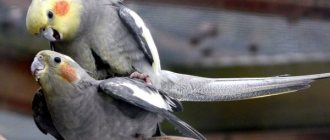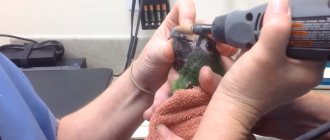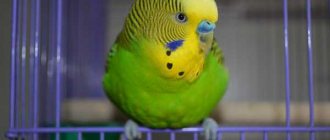- home
- Parrot
- FAQ
09/16/2019 Most female parrots lay eggs several times during their lives. This happens both during breeding and in the absence of a male and fertilization. Usually the process occurs without human intervention, but in sick and weakened females difficulties may arise. In such cases, you need to know what to do and how to avoid serious consequences.
Corella laid an egg: what to do
So, cockatiel eggs appeared in the bird cage. What should you do, should you start panicking? It just depends on how many birds are in the cage.
With a male
When a female and male cockatiel are kept in a cage, it is believed that two clutches of eggs per year is a safe amount that will not harm the health of the female. In nature, the reproduction of these parrots occurs during the rainy season, while at home - upon the onset of the most favorable conditions, called the “mating season.”
When an egg appears in a cage with two birds, the parents sit on the eggs and, with proper care, they produce healthy offspring. In the future, the chicks can be “placed” (given away or sold) through various forums and websites. They will definitely be in demand, because cockatiels are quite smart birds that can be taught to talk.
Of course, you need to be prepared for the fact that you will have to support chicks. Caring for a bird brood is a rather difficult task that not everyone can do. If the owner is not ready or does not need the chicks, the eggs must be removed from the cage. This must be done carefully, because this can put the parent birds into a state of stress or force them to re-lay, which will negatively affect the health of the female.
If parrots live in pairs
Keeping budgerigars in pairs involves producing offspring under favorable conditions. Oviposition is allowed 2-3 times a year, otherwise the process greatly weakens and depletes the female’s body and can lead to her death.
Start of masonry
If the female, kept in pairs, laid an egg, then there is no need to interfere with the incubation process. The bird will do everything on its own; parrots have highly developed care for their offspring.
A nesting house should be installed in the cage (or taken outside by making a hole in the bars) and equipped for comfortable incubation of the clutch. An egg laid “out of place” is carefully transferred to the nest. The female will lay subsequent clutches in the house.
The frequency of appearance of the next eggs is once every 2-3 days. Delays in term may indicate health problems in the female. Perhaps the egg is stuck in the oviduct. The wavy should be inspected.
During incubation, the bird practically does not leave the house, sometimes leaving only to empty its intestines. The male is responsible for feeding the pair.
When starting hatching, it is recommended to provide the birds with peace and not interfere with the process. However, you can carefully monitor its progress by periodically looking into the house through the hinged lid.
This must be done carefully: without sudden movements. You should accustom the bird to a possible invasion in advance by coming up with a “conditioned signal”. This could be a calm conversation or light tapping on a house or cage.
The female may react aggressively to such an action of the owner (screams, attacks). You should not force her to endure your presence or force her out of the house.
What factors provoke egg production?
In the wild, cockatiels usually breed in spring and summer. This is due to a number of factors that stimulate sexual behavior in birds. Domesticated birds are affected by several other external stimuli that can cause egg production in the pet.
Provoking factors for egg laying
- Rich diet . An abundance of protein and fatty foods can provoke sexual behavior in birds. After all, these substances are primarily necessary for the formation of eggs and the growth of chicks. Products rich in these components include sunflower seeds, nuts, oilseeds, and animal feed. A varied diet and the presence of various tasty treats in large quantities also contribute to a favorable time for reproduction.
- Increasing daylight hours . In nature, the nesting period is a seasonal phenomenon. From the beginning of March, daylight hours become longer, which is a signal for birds to reproduce. At home, it can be increased thanks to artificial lighting, a TV or computer running in the evening.
- Ambient temperature. A warm, humid climate also signals the beginning of the mating season.
- Presence of neighboring birds. When kept together with other birds, the cockatiel may also begin to lay eggs. The incentive for this is the presence of a female sitting on the nest or an individual demonstrating mating behavior.
- Toys or mirror. In the absence of a partner, the cockatiel may mistake an object or its own reflection for it.
- Affectionate treatment of a person. By showing his love for the parrot in the form of stroking the plumage, the owner can provoke a desire in the bird to lay an egg. This is because these actions are similar to courtship among birds. If you finger the feathers on your pet’s head, stroke it on the back and under the wings, then the person’s hand can be regarded as a sexual partner.
Affectionate treatment of a person is perceived as a partner - Pet's emotional state. If your bird lays eggs, it means she feels completely safe and enjoys life. In conditions of constant stress, illness and lack of attention, the parrot is unlikely to think about procreation.
Causes of jams
If your pet is completely healthy, laying is unlikely to be delayed and is usually due to hypothermia, improper positioning or large egg size. The age of the bird also affects: the egg gets stuck more often in young females who are laying eggs for the first time, or in old ones, because their muscles gradually weaken.
However, most often, illness, unsuitable living conditions and improper nutrition of the female lead to difficulties during laying.
- If hygiene is poor, the parrot suffers from infections or parasites that weaken the body and also cause inflammation of the oviduct, as a result of which it becomes impassable.
- Due to colds and other illnesses, the bird may not be strong enough to lay an egg.
- Frequent oviposition exhausts the female.
- Poor nutrition, obesity or lack of exercise make muscles weak.
- If an animal does not receive enough calcium in its diet, this leads to the formation of an egg with a thin shell, which is more difficult to push out, as well as muscle dysfunction.
To prevent frequent laying in the absence of the male, give the female less high-calorie and protein food and remove everything from the cage that is suitable for nest building: for example, put a feeder of a different size. It is advised to suppress any behavior that is associated with reproduction in parrots: remove toys hanging over the perch, do not stroke the female on the back, reduce daylight hours.
Is it possible to throw away
One egg laid by a female budgerigar does not threaten anyone. Breeders recommend leaving it in a cage to allow the bird to feel its maternal instinct. However, after a few days the clutch must be quietly removed, since the female sitting on the nest cannot fully feed. She doesn't have a partner to feed her. She cannot leave her home for a long time, taking care of the offspring that are not destined to hatch.
Non-stop egg production is another circumstance that forces the owner to get rid of “dummies”. The situation when the female takes care of the “offspring” forces her to starve, and replenishment of the clutch leads to exhaustion of the body. The shell uses up mineral reserves and also consumes energy. The bird is preparing to become a mother and plucks the feathers on its belly to keep its eggs warm. She experiences pain and discomfort associated with egg laying.
Attention! To protect your parrot from senseless losses, you should take the eggs laid by the female from the cage. This measure is forced, but necessary. In addition, it is necessary to suppress the reproductive instinct of the bird.
How can you tell if a parrot is preparing to lay eggs?
There are some signs by which a person can understand that a parrot is preparing to bear an egg: the bird becomes active, can imitate sexual intercourse with toys in a cage or a person’s hand, and its appetite increases.
When a parrot prepares a place for laying, begins to raise its tail, its cloaca enlarges, and its breathing quickens, then, most likely, it is preparing to lay an egg.
If the bird is alone in the cage, then it is clear that the egg will be unfertilized. To be sure, hold the egg up to the light. In an unfertilized egg, you will not see an embryo with blood vessels.
It remains to be found out why a female parrot lays eggs without a male. As it turns out, this is a fairly common phenomenon, intended by nature itself. Normally, all living beings should procreate. This is how birds bring offspring, even without the participation of a male. And if this happened, it means that man created the necessary conditions for this.
When a parrot lays one egg without a male, you shouldn’t be too scared. The concern should be the continuation of the clutch the next day, the bird can lay eggs one after another, what should be done in this situation? They should be removed from the cage so as not to cause the bird the need to reproduce. But it is worth noting that some professional breeders recommend doing this not immediately, but after some time, when the bird sits on them for a while and satisfies its instinct. This way you will not suppress the natural principle in the bird and will not discourage the desire to reproduce in the future, when you want offspring and acquire a male.
Frequent clutches deplete the body, chronic lack of calcium can lead to weakening of the limbs, wings, loss of feathers, the development of serious diseases, hormonal imbalance, and in some cases it causes the death of the bird.
What to do if your cockatiel lays an egg?
There is no need to panic, nothing bad has happened yet. This type of parrot has a predisposition to this phenomenon, but with the help of a number of actions the process can be controlled. However, the cockatiel’s frequent egg laying cannot be ignored, as its body becomes depleted and the pet’s lifespan may be reduced.
The owner has only two options for further action:
- leave the clutch and let the bird sit for the prescribed period;
- abruptly stop the process by getting rid of the eggs.
What to do with a laid egg
Is it possible to remove an egg from a cage?
Some parrot owners believe that if a nesting box is not placed in the cage, the bird will not lay eggs. However, the female can lay an unfertilized clutch directly on the floor or in a tray. If a female parrot lays an egg without a pair, a chick will not hatch from it, so there is no point in letting the bird incubate the clutch and waste its energy on it. In addition, unfertilized eggs crack easily; the female can learn to break them herself, which in the future will prevent her from hatching a normal clutch. Therefore, it is better to remove all eggs immediately after laying. Another option is to set up a nesting box, let the female make and hatch a full clutch, and then remove it.
What to do if the egg is inside the oviduct
In difficult cases, when the first aid provided by the owner to his pet did not produce results, and the egg got stuck inside the oviduct, the help of a specialist is needed.
First, the veterinarian must determine the location of the egg and its position. This can be done either by palpation or by radiography. In addition, the cause of the pathology is determined.
As a rule, it is associated with insufficient muscle tone. In this case, the veterinarian injects the bird with oxytocin, a hormone that increases muscle contractions.
In difficult cases, surgery may be performed to remove the stuck egg.
Did your parrots have chicks?
Not really
Bird help options
It is best if your pet is assisted by an avian veterinarian. But if you can’t turn to him, there are safe ways to help your parrot lay an egg.
- Heat helps the oviduct muscles contract: place a heating pad under the bottom of the cage or place a bowl of hot water nearby. Attention! If your parrot is bleeding or has blood in its droppings, this should not be done.
- You can give a few drops of petroleum jelly (not to be confused with regular petroleum jelly) into the bird's beak from a pipette.
- Place Vaseline or vegetable oil (sunflower, apricot or peach) into the oviduct. First, it is sterilized: boiled for an hour in a water bath, then cooled. For application, use a pipette, a syringe without a needle, or a soft brush washed with chlorhexidine or miramistin.
- Handle the parrot very carefully so as not to crush the egg.
- If the bird does not resist, you can give it a light massage on the back and base of the wings. This helps relieve the pet of tension and stimulate contractions of the oviduct.
As soon as the egg is released, a chilled Stroud's solution (water, citric acid and soda) is instilled into the cloaca. If this does not happen, you will need urgent help from a specialist. The veterinarian will take x-rays to see the position and size of the egg and may give the bird oxytocin to stimulate contractions in the oviduct.
When a parrot is in critical condition, the doctor drains the egg to relieve pressure on the organs. The egg is pierced with a hollow needle, through which its contents are removed. Muscle contractions caused by the medicine help push the shell out, but sometimes surgery is also used.
There are often tips to push a stuck egg through with your hands, pressing on the abdomen. Under no circumstances do this if you have no experience. Shell fragments can cause serious injury and can be difficult to remove.
Can a boy parrot lay an egg?
Owners of male parrots are often taken by surprise when their pet suddenly begins to lay eggs. This process is unnatural, since the male body simply does not have organs that could be responsible for this. The conclusion is simple: the pet store mixed up the sex and mistakenly sold a female instead of a male.
This phenomenon is very common, since most of these stores are staffed by animal lovers, not professionals, which causes such confusion, because determining the sex of a bird is more difficult than that of a cat or dog. If you find yourself in such a situation, all you have to do is change your name to a feminine one and come to terms with the fact that now you will have a girl living with you and she will need appropriate care.
Find out how to breed budgies at home and what to name the feathered boys and girls.
Can sudden egg laying lead to chronic egg laying?
If the conditions for keeping the bird by its owner do not change, then the development of chronic egg laying is possible in the future. Therefore, if an egg appears, then it is urgent to improve the conditions for keeping the bird. To do this you need:
- add calcium glucanate to drinking water for several weeks, since any egg-laying depletes the calcium “depot” in bone tissue - “calcium is washed out of the bones.” - provide the bird with a large amount of green feed, primarily sprouted grains, vegetables, fruits, and berries. - provide the bird with clay. - provide the bird with constant walking. — have the bird examined by an avian doctor, since sudden egg laying is a sign of health problems in the bird. Healthy parrots, canaries, and finches do not lay eggs outside the nesting period.
Oviposition in parrots
Oviposition in parrots occurs as follows: after the birds mate, the yolk enters the female’s oviduct, where fertilization occurs. Next, the ready-made embryo is sent to the uterus, where the protein is deposited and the shell appears. After the finished egg has fully matured, it goes back and exits through the cloaca.
Can a female lay an egg without a male?
To breed parrots, of course, you need a pair. One partner cannot produce new life. However, many owners of female parrots noticed that, being the only pet, she carried eggs. The thing is that a happy bird develops too much maternal instinct, and she wants to continue her family.
The main reasons for this phenomenon are:
- daylight hours are too long;
- excess attention;
- lack of protein in the feed.
What to do: how to prevent masonry
In order to prevent masonry, it is necessary to exclude the possible causes that were indicated above, namely:
- Adjust daylight hours, reducing it to 8 hours. The owner must determine a schedule convenient for himself (when it will be possible to pay attention to this moment) and at the end of the parrot’s eight-hour wakefulness, cover the cage with a dark, dense cloth.
- Balance your diet. First of all, it is necessary to exclude all products that contain vitamin E, since this substance stimulates the female’s body to procreate.
- Also, as an additional method, you should temporarily avoid touching the animal , since a strong bond between a pet and a person can also stimulate reproduction.
Ways to stop egg laying
If a female without a male lays eggs from time to time, the following reasons must be eliminated:
- Reducing lighting time to 10 hours a day. The bird can wake up at dawn and stay awake until nightfall. To prevent this from happening, cover the cage with a dark cloth in the evening. This way the parrot will gradually get used to the winter regime.
- Remove items for building nests from the cage: a house, a hammock, a hatch. Also, get rid of the mirror and toys to play with. Touching and stroking should be limited, as they cause tactile sensations similar to those experienced during pregnancy.
- Adapt the bird's diet by eliminating foods containing vitamin E (this component of vitamin E allows the body to reproduce). Sprouts should be removed from the menu. On the contrary, mineral foods should be given in increased quantities to compensate for calcium deficiency.
- Lower the room temperature. If this requires frequent airing, the birdcage should be removed or covered with a towel.
Distract your fluffy parrot from nesting with interesting activities: walks, bathing, games and communication with the owner. Little winged pets love attention and care and are happy to make contact. If you have time, training wolves and teaching speech is great. A bird that is not bored by itself becomes attached to a person. It does not need the company of other birds and is less subject to its natural instincts.
A female parrot can lay an egg without the participation of a male. He is encouraged by the good conditions created by the owner. Egg laying may be interrupted due to a slight disturbance in the bird's smooth movement.
